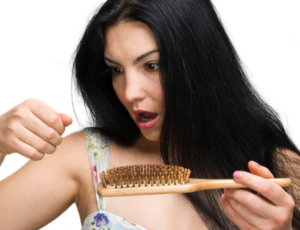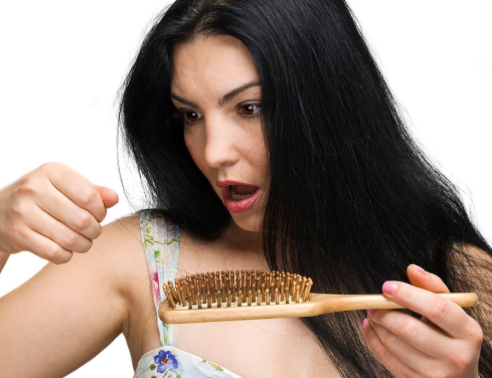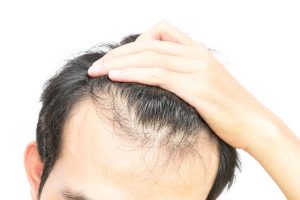
Yes, it absolutely can be your hormones and it often is! While I’ve seen hair loss due to low iron and other nutritional deficiencies, I usually see patients with thinning hair due to hormonal causes.
The most common form of hair loss for men and women is called androgenic alopecia, also known as male pattern balding. In men it is very common and socially accepted, and has everything to do with a form of testosterone called DHT (Dihydrotestosterone). This same form of testosterone is also responsible for hair loss in many women. DHT is a form of testosterone that is responsible for increased growth of facial hair and a miniaturization of hair on the scalp. Testosterone gets converted to DHT via the enzyme 5-alpha reductase. This enzyme is in the oil gland of the hair follicle, so when it contacts testosterone it can convert it to the hair-shrinking hormone, DHT.

Androgenic alopecia can occur in woman due to ovarian cysts, the taking of high androgen birth control pills, pregnancy, and menopause. It is common in conditions such as polycystic ovary syndrome (PCOS) where there is a reduction in progesterone and an increase in circulating androgens. It also begins in woman around perimenopause and menopause when female hormones begin to decline along with serum hormone binding globulin (SHBG). As the name implies, SHBG binds hormones, such as testosterone, making them less bioavailable. So while total testosterone may not be increasing during menopause, the amount available to reach target cells does increase, thus allowing DHT to rise and hair to thin.
It is actually more complicated than just pointing to any one hormone, as there is a relationship between the hormones and their interaction impacts hair. Adequate estrogen is important for hair growth, but too much may be associated with exacerbating hair loss. The hormone progesterone can counteract testosterone and administration in PCOS cases seems to significantly support hair growth. It may all seem very confusing, but with consultation, education and the appropriate tests, I assure you, it can make sense.
Thyroid and stress hormones also impact hair health. It is well known that after a period of intense stress, hair can fall out by the handfuls. This condition called telogen effluvium, often begins 3-6 moths after a stressful event. It commonly resolves within a few months, but for some individuals it can continue for years. Thankfully, this type of hair loss is reversible. The hormone involved with stress induced hair loss may be cortisol. Elevated amounts seem to be associated with DNA damage to the hair follicle resulting in hair loss and loss of pigmentation. It also seems to be associated with a shortened hair growth cycle. Conversely, too little cortisol can also cause hair loss. Cortisol affects thyroid function and if it declines, so does the active thyroid hormone. Again, the interaction between cortisol and thyroid is quite complicated and too lengthy for this article. The take home message is: acute and chronic stress, if not managed can wreak havoc on your health! Hair is dispensable as far as the wisdom of the body is concerned, so hair is first to be affected.
As I have just mentioned, thyroid hormones also have a role in this hairy tale. Thyroid hormones control your rate of metabolism, or energy expenditure. If thyroid function declines, hair becomes dry, brittle and thinner. Too much thyroid hormone, or hyperthyroid, can also cause hair loss.
Thinning hair is not the end of the world as there are many treatment options to help restore your crowing glory. The starting place is to determine the cause of hair loss and begin an appropriate treatment plan. Basic blood work that includes a CBC with differential, and iron panel or ferritin, thyroid tests, basic hormones including DHEA and inflammatory markers is a great starting place. Combine these tests with good history taking and the cause of hair loss is often easy to determine. In more complex cases I may recommend food allergy testing, an adrenal panel or a complete hormone test like the DUTCH test.
Once we have determined a cause, a treatment plan will be developed. It can be as simple as prescribing a hormone based shampoo or a combination of therapies such as PRP for hair regeneration combined with nutritional supplements and possibly the addition of a prescription shampoo. The beauty with prescription hormone shampoo is that they target the source (hair follicles) with less systemic impact than oral hormones.
PRP for hair regeneration is a very exciting treatment. Yes, it does involve injections into the scalp, but when hair starts re-growing and thickening, it becomes all worth it. The recommendation for PRP hair regeneration is 2-4 treatments 4-8 weeks apart. It takes up to 3 months to notice the benefits of the treatments.





